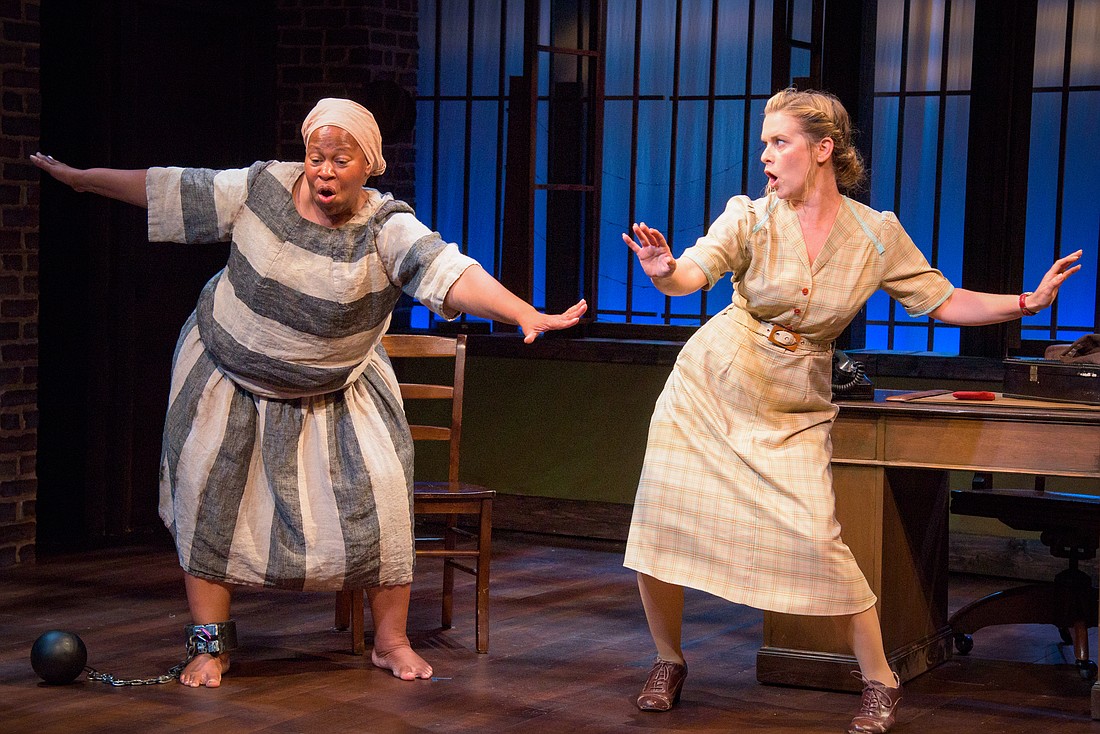- October 22, 2024
-
-
Loading

Loading

Time is cruel to art — music especially. The authentic (and unprofitable) folk songs of the past are often silenced. Why do a few still play? It’s often because someone fought against the silence. Frank Higgins’ “Black Pearl Sings!” brings a fictionalized version of this very real fight to Florida Studio Theatre.
Back in the 1930s, “song-hunters” like Alan and John Lomax crisscrossed the country making recordings of genuine roots music. Susannah Mullally (Rachel Moulton) is the play’s fictional folklorist. She’s on a quest for Black folk songs. Not distorted, contemporary versions — as close to the originals as she can get.
Susannah’s search takes her to a Texas prison, where she finds Alberta “Pearl” Johnson (Alice M. Gatling). This woman has a powerful voice — and powerful memories of slavery-era songs passed down by her Gullah ancestors. Most of those songs remain unrecorded.
If Susannah adds Pearl’s songs to the Library of Congress audio archive, she’ll achieve the lofty goal of preserving history. But Susannah is an underpaid musicologist. Those recordings will win her an academic position and a decent income.
But Pearl’s indifferent to Susannah’s mixed motives. This white lady wants recordings of the old songs? Fine. Pearl wants something in return. The archivist gets her out of prison, but that’s not enough. Pearl demands that Susannah help find her missing daughter. If she can’t help, Pearl will remain silent.
Pearl’s music is her only leverage. And she intends to use it for all it’s worth. The tug of war continues throughout the play. Pearl releases one song for every clue Susannah finds. But she keeps the song her ancestors brought from Africa in her pocket.
Director Kate Alexander makes the most of Higgins’ strong characters and razor-sharp dialogue. It turns on a dime from heartbreaking to hilarious. The actors make the most of it, too.

Gatling’s portrayal of Pearl reprises her performance in FST’s 2009 production and the play’s 2007 premiere. She definitely owns this tough, unsentimental character. Her Pearl has no illusions about the machinery of the white power structure (do-gooders and bleeding hearts included). She doesn’t spare Susannah’s feelings — and speaks her mind about her white savior’s hypocrisy. Gatling’s singing voice comes from the depths of her soul. With never a false note.
Moulton’s Susannah is no saint. But the playwright doesn’t set her up as a cardboard villain, either. Despite her character’s flaws, Moulton plays her as an idealist. Susannah doesn’t become bosom buddies with Pearl. But the two characters do form common cause before the final curtain. It just takes lot of bickering to get there.
This human chess game comes to life in Isabel & Moriah Curley-Clay’s two sets — the warden’s spartan office in the first act; and a wealthy bohemian’s New York City walkup stuffed with books and art in the second act.
From prison stripes to evening gowns, Nia Safarr Banks’ costumes are visual shorthand for the era’s identity code. Ethan Vail’s lighting goes from realistic (in the present) to phantasmagoric (in moments of memory and imagination).
Louis Vetter Torres’ music design is vital in this play. “Black Pearl Sings!” isn’t a musical. But it’s packed with music — with songs like “Down on Me” and “This Little Light of Mine” punctuating the spoken world dialogue. Torres makes the music seem like the background score of the play’s world, not a stagey interruption.
But who wins the chess game? Does the constant verbal (and occasionally physical) sparring between Susannah and Pearl make any sense?
Dramatically, you’d better believe it.
Every story needs a conflict, as they teach you in high school English class. The conflict driving this story is clever, but it seems like obvious artifice. The scene where Susannah asks Pearl to perform in a chain gang uniform seems like pure fiction. In this case, art does imitate life.
Music got Huddie “Lead Belly” Ledbetter out of prison. Musicologists Alan and John Lomax made him perform in prison stripes for wealthy white audiences up north. (The blues legend didn’t like it any more than Pearl does.)
After experiencing Higgins’ smart, heartfelt play, you won’t take the old songs for granted ever again. The playwright shows the cost of what it took to save them from silence.
Correction: This article has been updated with photos of the current production and cast.